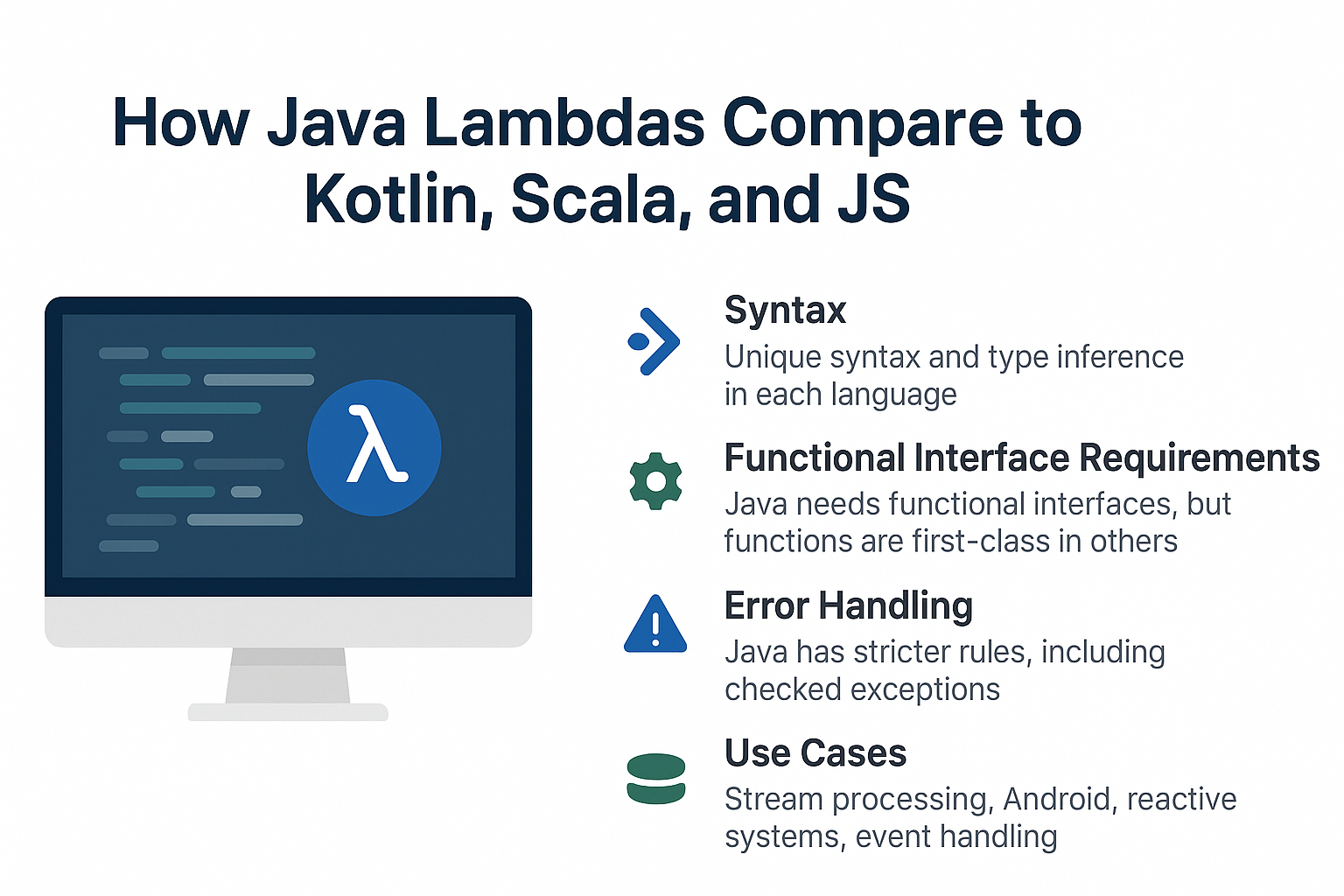Lambda expressions are a cornerstone of modern programming languages. Java introduced them in version 8 to bring functional programming capabilities to the language, but how does this implementation compare with other popular languages like Kotlin, Scala, and JavaScript? In this tutorial, we’ll compare the syntax, semantics, performance, and real-world usage of lambdas in Java with similar constructs in Kotlin, Scala, and JavaScript.
We’ll also examine where Java lambdas stand in terms of verbosity, readability, and functional flexibility.
What Are Lambdas?
In all four languages, lambdas represent anonymous functions — blocks of code that can be passed around as data and executed later. Lambdas allow for more expressive and declarative code.
Java Example:
Function<Integer, Integer> square = x -> x * x;
Kotlin Example:
val square: (Int) -> Int = { x -> x * x }
Scala Example:
val square = (x: Int) => x * x
JavaScript Example:
const square = x => x * x;
Syntax Comparison
| Feature | Java | Kotlin | Scala | JavaScript |
|---|---|---|---|---|
| Function Type | Function<T, R> |
(T) -> R |
(T) => R |
Arrow functions |
| Type Inference | Partial | Full | Full | Full |
| Single Expression Lambdas | Yes | Yes | Yes | Yes |
| Multi-line Support | With braces {} |
With braces {} |
With braces {} |
With braces {} |
| Return Statement | Required if braces used | Optional | Optional | Optional |
Integration with Collections
Java
List<String> names = List.of("Alice", "Bob", "Charlie");
names.stream().filter(name -> name.startsWith("A")).forEach(System.out::println);
Kotlin
val names = listOf("Alice", "Bob", "Charlie")
names.filter { it.startsWith("A") }.forEach(::println)
Scala
val names = List("Alice", "Bob", "Charlie")
names.filter(_.startsWith("A")).foreach(println)
JavaScript
const names = ["Alice", "Bob", "Charlie"];
names.filter(name => name.startsWith("A")).forEach(console.log);
Performance Considerations
- Java: Lambdas are compiled into bytecode as
invokedynamicand leverageLambdaMetafactoryto generate classes at runtime. This offers performance closer to anonymous classes. - Kotlin: Lambdas compile into Java bytecode but can incur extra allocations when capturing variables.
- Scala: Scala lambdas are powerful and idiomatic but may result in heavier bytecode due to the language’s complexity.
- JavaScript: Lambdas (arrow functions) are syntactic sugar and perform identically to traditional function expressions.
Functional Interface Requirements
- Java: Lambdas must target a functional interface (an interface with exactly one abstract method).
- Kotlin/Scala/JS: Functions are first-class citizens and don’t need a functional interface.
Scoping and Variable Capturing
Java requires captured variables to be effectively final, whereas Kotlin, Scala, and JavaScript have more lenient (or mutable) closures.
Error Handling
Java lambdas can’t throw checked exceptions unless wrapped explicitly.
Function<Integer, Integer> risky = x -> {
try {
if (x < 0) throw new IOException();
return x;
} catch (IOException e) {
throw new RuntimeException(e);
}
};
Other languages don’t enforce checked exceptions.
Use in Concurrency
Java
new Thread(() -> System.out.println("Running")).start();
Kotlin (with coroutines)
GlobalScope.launch {
println("Running")
}
Scala (with Futures)
Future { println("Running") }
JavaScript (with Promises or async/await)
(async () => console.log("Running"))();
📌 What's New in Java 21?
- Java 8: Lambdas,
java.util.function, Streams API, method references - Java 9:
Optional.ifPresentOrElse, Flow API - Java 11:
varin lambda parameters - Java 17: Pattern matching previews
- Java 21: Structured concurrency and virtual threads — both pair well with lambdas for modern async patterns
Real-World Use Cases
- Java: Stream processing, GUI event handlers, concurrency callbacks
- Kotlin: Android development with higher-order functions
- Scala: Reactive systems, Spark pipelines
- JavaScript: Event listeners, promises, array manipulation
Anti-Patterns
- Excessive chaining that reduces readability
- Capturing mutable variables
- Unchecked exception leakage in Java lambdas
- Overuse of lambdas instead of clear method calls
Conclusion and Key Takeaways
- Java’s lambdas are powerful but come with more restrictions than Kotlin or Scala.
- Kotlin offers great syntax brevity and better type inference.
- Scala has the richest functional ecosystem but a steeper learning curve.
- JavaScript arrow functions are great for simple, concise code but lack type safety.
Use Java lambdas when working in enterprise-grade systems, especially when paired with Streams, Optional, and structured concurrency.
FAQ
1. Can Java lambdas throw checked exceptions?
Only if explicitly handled or wrapped.
2. What’s the difference between a Consumer and a Function?
A Consumer returns nothing; a Function returns a value.
3. Are Java lambdas better than anonymous classes?
Yes, in terms of readability and boilerplate. But anonymous classes allow more flexibility like multiple method overrides.
4. Do Kotlin lambdas outperform Java lambdas?
In many cases yes, due to JVM bytecode optimizations and coroutines — but it depends on the context.
5. Are Java lambdas garbage collected?
Yes, like any object if no references exist.
6. Can lambdas be serialized in Java?
Only if the target interface extends Serializable.
7. Should I always use lambdas?
No. For complex logic or debugging, named methods or anonymous classes may be more readable.
8. How do lambdas work with Spring?
They're commonly used in callbacks, stream processing, and DSL-like builder APIs.
9. Do lambdas work with virtual threads?
Yes. Virtual threads in Java 21 work well with lambdas for lightweight concurrency.
10. Can I debug lambdas?
Yes, but stack traces may be harder to read unless named appropriately or split into separate methods.
